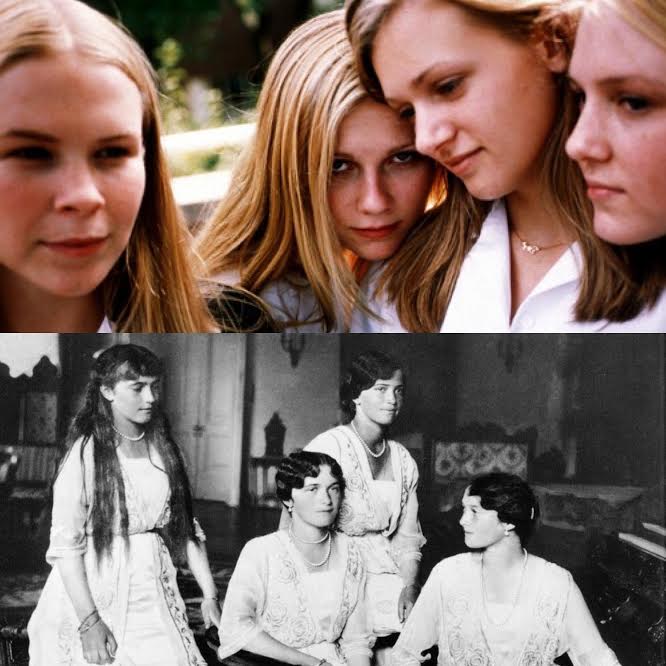This guest post written by Isabella Garcia appears as part of our theme week on Sisterhood.
Two sets of sisters, different in circumstance but alike in experience. The first sisters are the four Romanov Grand Duchesses of Russia: 22-year-old Olga, 21-year-old Tatiana, 19-year-old Maria, and 17-year-old Anastasia. The second are the four Lisbon sisters from 1970s Michigan in Sofia Coppola’s The Virgin Suicides: 17-year-old Therese (Leslie Hayman), 16-year-old Mary (A.J. Cook), 15-year-old Bonnie (Chelse Swain), and 14-year-old Lux (Kirsten Dunst). Cecilia (Hannah Hall), the fifth Lisbon sister, is excluded here because the similarities between both sets of sisters come rushing in after her suicide in the beginning of the film. Clear links between the two sets can be drawn, but ultimately reveal that in both situations, living in a gilded cage only leaves behind a haunting memory.
As Grand Duchesses, the Romanov sisters were normally in the public eye and considered to be the most photographed royals of the early 20th century. From the outside, they were thought to be fashionable, charming, pretty, and inaccessible. Rarely apart, they were seen as a single force rather than individuals, wearing the same white lace dresses and hats. This didn’t seem to bother the girls, and instead, the sisters would reinforce this by collectively referring to themselves as OTMA, the first letters of their names. While the Romanov sisters were continually in the limelight, the Lisbon sisters in The Virgin Suicides were under the watch of the neighborhood boys’ eyes. Seen as unattainable and ethereal in their white peasant dresses, much like those that the Romanov princesses wore, the boys fell for them. They become so enamored with the idea of them that at one point after Cecilia’s suicide, the boys pore over Cecilia’s discarded diaries in an effort to get into the sisters’ minds, much like what historians do with the preserved Romanov sisters’ diaries:
“We started to learn about their lives. Coming to hold collective memories of times we hadn’t experienced. We felt the imprisonment of being a girl. The way it made your mind active and dreamy and how you ended up knowing what colors went together. We knew the girls were really women in disguise, that they understood love, and even death, and that our job was merely to create the noise that seemed to fascinate them.”
Despite what fantasies others created of them, both sets of sisters were just simple girls. Helen Rappaport’s book The Romanov Sisters: The Lost Lives of the Daughters of Nicholas and Alexandra sheds light on this very fact, delving into the duchesses’ often speculated private lives. It may come as a surprise that they weren’t treated as royally as everyone thought; instead, they were brought up quite humbly, living rather repetitive lives. In an article about Rappaport’s book, writer Yelena Akhtiorskaya comments on her bewilderment at the fact that “the girls take baths, play hide-and-seek, drink tea, get measles, [and] love each other” when she was expecting something more grandiose and compelling. The Romanov and Lisbon sisters fell in love with unattainable boys, complained about not being able to go out, and silently worried about their future. Even their rooms, which carried an ethereal quality to them, seem to be alike. The duchesses covered the walls with colorful throws and shawls and placed small knick-knacks, icons, and pictures on their bedside tables to make the room more welcoming.
Although the Grand Duchesses would seldom go out, their birthdays were events to be celebrated. Most likely the sisters’ favorite night was Olga’s 16th birthday debut in the Palace in Livadia at the Crimea. Escorted to the ball by her favorite officer Nikolay Sablin, Olga beamed with joy and danced for the rest of the night. Tsarina Alexandra wasn’t fond of frivolous aristocratic balls and only allowed Olga and Tatiana, whom she called the “Big Pair,” to attend three more balls in their lifetime. Even so, this quick appearance from the girls caused partygoers to realize that “despite the limitations of their till now sheltered lives, ‘they were simple, happy, normal young girls, loving dancing and all the frivolities which make youth bright and memorable’.” In much the same way, the Lisbon sisters’ last taste of freedom comes when Mrs. Lisbon (Kathleen Turner) begrudgingly allows them to attend the homecoming dance with dates from the football squad. The sisters attend the dance wearing four identical white flowery dresses with slight variations, but they don’t complain as they’re too excited to finally get a chance to go to a school dance. During the night, the girls have their first kisses, slow dance with their dates, and Lux and her date Trip Fontaine (Josh Hartnett) win homecoming king and queen. Nearing the end of the dance, the eldest sister Therese turns to her date and delightedly tells him that she’s having the best time. Unfortunately, the girls get thrust back into their restrictive reality after Lux doesn’t make it home with them that night. She spends the night on the football field with Trip and doesn’t come home until the next morning, much to her parents’ anger.
It’s because of this and their exposure to the dangers of the outside world that Mrs. Lisbon and Tsarina Alexandra chose to isolate their daughters from everyone. Seeing it solely as a benefit to their safety and well-being, both mothers tucked them away — into the Lisbon household and the Romanov palaces. For Mrs. Lisbon, she seeks to protect her daughters from the prying eyes and hands of high school boys, while the Tsarina wished to keep OTMA away from the charged political climate of the time and possible assassination threats against the family. Mrs. Lisbon pulls the girls out of school after Lux’s failure to make curfew, while the Grand Duchesses were privately tutored at their home. Both sets of girls didn’t make or have friends their age apart from each other. The Romanov girls could only make friends with their tutors and the soldiers that oversaw their daily lives. Desperate for any contact with the outside world, Anastasia and Maria would routinely ask the soldiers to tell them stories about people on the outside. Rappaport sympathizes with them:
“With hindsight one might say that in being denied contact with young men and women of their own social standing and the life experiences that went with it, the sisters were trapped in a stultifying, artificial world in which they were perpetually infantilized.”
This also applies to the Lisbon sisters where at one point in The Virgin Suicides, Lux tells her mother, “I can’t breathe in here.” To which Mrs. Lisbon responds, “Lu, you are safe in here.” For both Mrs. Lisbon and Tsarina Alexandra, their children are their life. Even Alexandra’s lady-in-waiting Elizaveta Naryshkina recognized this, but knew that Alexandra “does not understand that there are consequences to all mistakes, and especially her own.” Both mothers ardently desired for their children’s safety, but it only did more harm than good: pushing them further away from society. Little did both mothers know that hiding their families away would help incite their downfalls: the Lisbon girls’ suicides and the public’s distrust and then imprisonment and deaths of the Romanovs.
Tsarina Alexandra was quickly disliked by Russian citizens for seeming too distant and cold, which wasn’t helped by the fact that she made her family shy away from the public eye as often as possible. With the revolution breaking out in 1917, Tsar Nicholas was forced to abdicate while Alexandra and her children were placed under house arrest. It was only a year later when they were imprisoned in Ekaterinburg and ultimately met their demise. While there, the Romanov sisters lived a much stricter life than their house arrest. Like the Lisbon sisters, they weren’t allowed out apart from a stroll in their gated garden once a day. The Romanov sisters noted in their diaries their boredom and monotony, with each day passing just as the day before. Their dreary isolation didn’t go unnoticed by outsiders. Russian writer Nadezhda Mandelstam, who was the same age as Maria, wrote in her book:
“I suddenly understood that I was much happier than these unfortunate girls: after all, I could run around with the dogs on the street, make friends with the boys, not learn my lessons, make mischief, go to bed late, read all kinds of junk and fight — with my brothers and anybody else…”
After not seeing the Lisbon sisters for a couple of weeks, the neighborhood boys that longed to save them from their confinement believed them to be “living in the dead, becoming shadows.” The girls would have disappeared from their lives altogether if they hadn’t reached out to the boys by speaking with them via Morse code using their lights. When that doesn’t work as well as it should, they take to calling each other and playing songs that represent their feelings — from “Alone Again” by Gilbert O’Sullivan to “Run to Me” by the Bee Gees. When allowed over one night by the girls, the boys believe they’re helping the girls escape, but they end up being witnesses to some of their suicides. Although the Romanov family was under strict lockdown, two boys, Vladimir and Dimitri Storozhev, sons of a priest that would occasionally visit the family, also managed to get in contact with the girls by gesturing and talking over the fence to them. But nothing resulted of this contact. The Romanov family was violently executed by Bolshevik soldiers in a cellar on the night of July 16-17, 1918.
Both sets of deaths, the Lisbon suicides and the Romanov murders, were shrouded in mystery for some time after. For the Lisbon girls, people wondered why they did it; for the Romanov girls, people fantasized that maybe one of them managed to escape death. This theory has since been proven false, but that didn’t stop people from hoping. In The Virgin Suicides, the neighborhood boys describe their confusion about what happened to the Lisbon sisters as having only some “pieces of the puzzle, but however we put them together, gaps remained — oddly shaped emptiness, mapped by what surrounded them, like countries we couldn’t name.” And yet, only one thing is for certain. Despite being lumped together as a group and despite being seen as ethereal beauties, they were just girls. They wanted freedom to live their lives. They had hopes and dreams for a future taken from them too soon.
See also at Bitch Flicks: The Repurcussions of Repressing Teenage Girls in ‘The Virgin Suicides’ and ‘Mustang’; Sofia Coppola and the Silent Woman; Director Spotlight: Sofia Coppola
References: Rappaport, Helen. The Romanov Sisters: The Lost Lives of the Daughters of Nicholas and Alexandra. New York: St. Martin’s, 2014. Print.
Isabella Garcia is a California-based aspiring TV writer who can be found crying over movies, books, and TV on Twitter @isabellagrca and It’s Just About Write.









